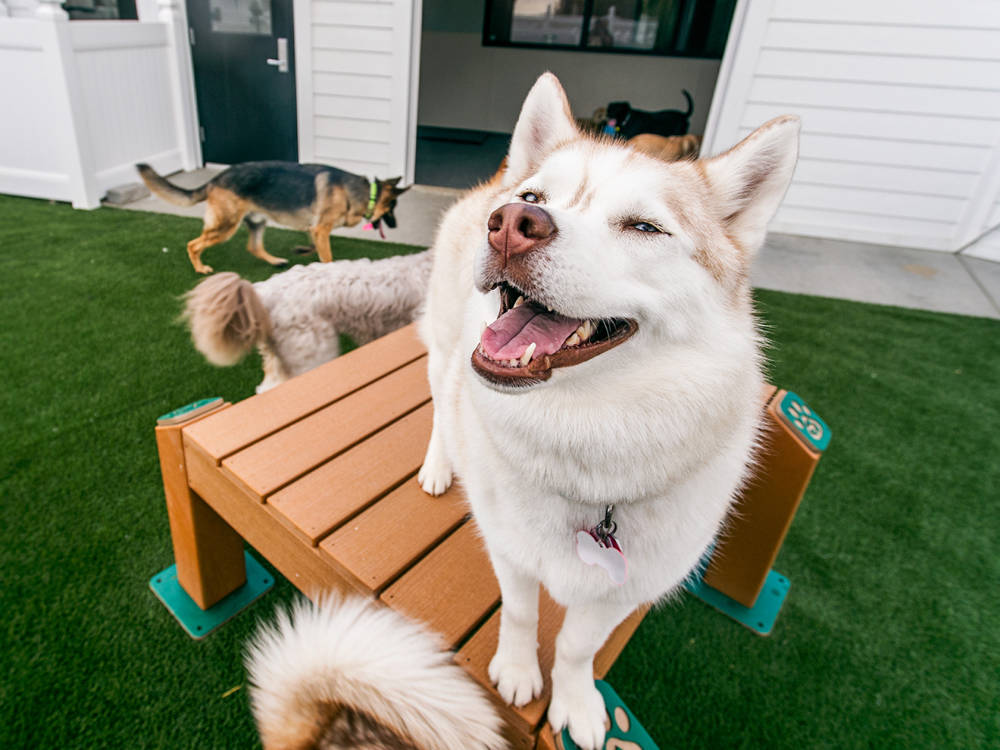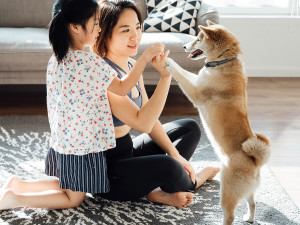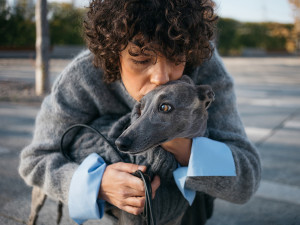Working Pet Parent? Doggie Daycare to the Rescue!
Find one they love, but not so much they won’t want to come home

Share Article
Family is everything. No question. But you also can’t wait to get back to your friends, right? Your dog may just share the sentiment. Whether your pup is a social butterfly or a stage-five clinger, if you’ve been stressing about how they’ll cope when you return to work, doggie daycare has got you covered. Your dog can have a social life and learn how to be comfortable when not glued to your side, while you can find comfort knowing they’re in good hands. Of course, not just any place will do. We caught up with Camp Bow Wow marketing scout August Martin to map out how to find the right playgroup for your pup.
Do some recon
If you’ve ever imagined quitting your day job and opening an eponymous doggie daycare, you’re not alone. Which is to say there are a lot of options out there, but all it takes is a little sleuthing to weed out the ones unworthy of your dog. First, check out a daycare’s website – a legitimate business should be fully insured. “Transparency with customers is important,” says August. “Can you see where your pup will be sleeping opens in a new tabor playing? Are there cameras so you can check on your dog while you’re working? It’s always nice to be able to see your dog and know they’re being well taken care of.” Next, read reviews. While they should be taken with a grain of salt, feedback from actual clients could rule a daycare in or out.

littleKin™ is Kinship’s home just for puppy and kitten parents. Bop over to check out expert advice, new pet tools, and special deals—all curated for your newest family member.
opens in a new tabAsk about safety procedures
Before you commit, ask a daycare staff member about the safety measures they have in place. Dr Elizabeth Shines has some suggestions: “Find out how they prevent dogs from accidentally getting loose. They should have a secure fence that’s at least six-feet tall, if not taller. They should also use a double-gate system when bringing dogs in and out of the facility, so there’s always one closed door between the dog and the street.
“Ask if they require that dogs be spayed or neutered, which can decrease aggression in general. And find out if they require vaccinations and parasite prevention, as those will reduce the likelihood that your dog will pick up fleas, kennel cough or another health issue. Lastly, I recommend asking questions about the staff. Are there enough people working to keep all the dogs safe and clean up messes quickly? Is the team trained in pet first aid? What will they do if there’s an emergency and they can’t get in touch with you? Answers to these questions will give you a sense of their overall approach to your dog’s safety.”
Consider your dog's personality
Just like people, there’s no one size fits all when it comes to dog personalities. Some revel in playing with as many dogs as possible. Others, not so much. The key is to find a daycare that can adjust to your dog’s unique needs, whether they’re a social butterfly or a wallflower. “I recommend asking if they do temperament tests on all of the dogs before allowing them in,” says Dr Shines. “Not all dogs are a good fit for daycare. Others are appropriate for daycare but may require more attention, so it’s good to understand if they’ve done an initial assessment before allowing dogs to mingle.”
August seconds this, and adds, “Ideally, they won’t just throw your pup into the pack. Look for a place that will take the time to make sure your dog feels comfortable and will work with them to overcome any nervousness.” Moreover, if your dog’s special needs are medical, it’s important to note that “not all facilities have staff trained to administer certain medications,” says August. “So if your dog is diabetic and needs insulin injections, you’ll need to make sure there is someone equipped to provide that service.”
Have your dog’s back
Do you enjoy being ambushed in social situations? Didn’t think so. And neither will your dog. Ease them into the daycare experience by socialising them with new people and pups. (This will also give you a better understanding of how your dog behaves around others, which you can communicate to the daycare.) If you plan on boarding them overnight, August suggests a few trial runs during waking hours before a sleepover. “That will help them get used to the environment and make their longer stay more comfortable. They’ll also start to understand that when you drop them off, you’ll always come back for them.”
Doggie daycare checklist
Robin Bennett, a dog trainer and author of All About Dog Daycare, shares a few tips about choosing the best daycare.
Cleanliness. There should be minimal offensive odour and immediate clean-up of accidents and the other dogs should be healthy-looking.
Playtime provided for the majority of the day. While a two-hour ‘naptime’ is common, during the rest of the day, your dog should have time to playopens in a new tab with staff members and other dogs.
Proof of current vaccinations. Distemper, parvo and bordatella vaccinations and/or titersopens in a new tab should be required.
Adequate supervision. Staff members should be physically in the rooms with the dogs at all times; supervising through a window or a gate is not enough.
Safe staffing levels. A good daycare facility maintains an approximate staffing goal of one person for every 10 to 15 dogs.
Assessment of a dog’s suitability for the daycare environment. An incoming dog should be tested to ensure that she enjoys the company of other dogs and should be acclimatised to the group slowly and safely. They should be placed in a group of dogs with play styles and energy levels similar to their own.
Safety arrangements. Small dogs and large dogs should be segregated.
Size of the facility appropriate for the number of dogs. Ideally, each dog needs approximately 70–100 square feet of space for safe off-lead play.
A staff with experience and knowledge in animal group behaviour. Look for staff members who attend seminars or have experience working with dogs in groups.
Appropriate control measures. Avoid daycares where the staff controls the dogs by routinely punishing or physically manipulating them. These control measures include interrupting the dogs by calling them away from a potential conflict, giving short (2–3 minute) time-out periods, or redirecting the dogs to more appropriate behaviours.

Kate Sheofsky
Kate Sheofsky hails from San Francisco, where she developed a love of writing, Giants baseball, and houses she can’t afford. She currently lives in Portland, OR, and works as a freelance writer and content strategist. When not typing away on her laptop, she enjoys tooling around the city with her two rescue pups searching for tasty food and sunny patios.
Related articles
![mom and daughter playing with puppy]() opens in a new tab
opens in a new tabHow to Introduce Your New Dog to Your Kids
They’ll always remember their first childhood pet – this intro is just the beginning
![French bulldog puppy looking scared at vet]() opens in a new tab
opens in a new tab10 Things to Ask At Your First Vet Visit
There are no stupid questions when it comes to your dog’s health
![greyhound dog being washed in tub]() opens in a new tab
opens in a new tabLather, Rinse, Repeat: the Ultimate Dog Grooming Guide
Keep your dog well-groomed but trust trims to the pros
- opens in a new tab
How to Tell If Your Dog Is a Hugger – Or Not
Boundaries, folks. Boundaries




